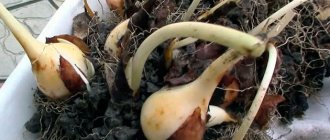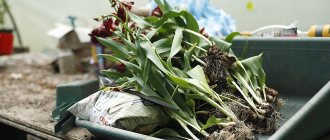Maria_Ivanova22 — Nov 18th, 2021 Categories: How to store
Narcissus does not please the eye for a very long time, but the pleasant fact is that it can be restored next season. To do this, you need to know the basic rules and methods of storing daffodils during the winter.
Ingredients: daffodils Time for planting: Autumn
Flower growers offer different options for saving daffodils until next spring. Some people prefer to leave them in the flower bed, but most experts in this matter are sure that it is better to dig up the plant’s bulbs and preserve them in this way until the planting season.
Daffodil bulbs
Author: Veronika Viktorova February 01, 2021 Category: Garden plants
Narcissus (Narcissus) is a plant that is propagated and grown from bulbs, so to obtain beautiful daffodil flowers it is important to choose high-quality planting material. The main thing is that the bulbs are not affected by the daffodil fly or, as it is also called, the bulbous hoverfly. Dangerous for daffodils and various types of rot.
Based on these warnings, you need to buy daffodil bulbs at specialized points of sale or online stores that have been selling planting material for a long time and have a decent reputation.
Daffodil bulbs are pear-shaped. They can be one-, two- or multi-vertex.
Briefly about daffodils
This plant, daffodils, belongs to the group of flower crops that grow for several years. There is no question about the fact that these flowers can grow in the same area all these years and even produce a wonderful flowering process. Every year, flower stalks become smaller and smaller, and this applies not only to daffodils, but also to other flower crops. I think it is now clear why it is worth removing the plant and giving it time to rest. All the time when the planting material is on a well-deserved rest, the bulbs replenish their reserves of energy and useful microelements, then in a renewed form they are ready to reward gardeners with a beautiful appearance, as well as an amazing flowering process.
When is the best time to buy daffodil bulbs?
If you are planting daffodils for the first time, then you need to buy the bulbs in the summer and plant them in late August or early September. In some warm regions, planting daffodils is allowed in early October. The main thing in this process is that the bulb has time to take root before frost.
After purchasing, the bulbs should be stored in a cool, dark place until planting.
If you are already growing daffodils and intend to use your own planting material, then the bulbs for replanting should be dug up in June. For two months until autumn, they should lie in a dark, dry place, for example, in a basement.
What types of flowers can be used
Early and middle varieties are more suitable for forcing - their growing season goes faster. But if the goal is not to get flowering by a certain date, any species will do, even late ones.
Regardless of the type of bulb for forcing, it is necessary to select only high-quality, healthy and preferably large ones, with a diameter of 4 cm. The exception is low-growing varieties, which have small bulbs. Until planting for forcing, planting material should be stored in a dry place at a temperature of 17 ° C.
Propagation of daffodils by bulbs
Reproduction of daffodils occurs by dividing and planting a bulbous nest. Young daffodil bulbs reach optimal size by 3-4 years of growth, so do not disturb them ahead of time. From the ripe mother bulb, children are separated - new bulbs that can be planted as independent plants. Daughter bulbs bloom, as a rule, already in the 1st year.
Sometimes a more complex method of propagation is used - in parts of bulbs. To do this, the bulbs are divided (cut) into several (for example, 4-6) parts. Each part of the bulb must be treated with a stimulant drug. After this, the parts are dried and planted in boxes with a sterile substrate, since the cut bulbs are very susceptible to disease.
Some gardeners also practice propagation of daffodils by seeds. But this is a long, painstaking, not very reliable path, and flowers grown in this way bloom only after several years.
Treatment of daffodil bulbs against diseases
Daffodil bulbs sometimes suffer from various diseases , most often from bacterial and penicillium rot, fusarium, sclerotinia, and mosaic disease. How to care for daffodils?
To prevent the plant from dying and getting sick after flowering, it is sprayed with a solution of copper sulfate at the rate of 100 g of sulfate per 10 liters of water.
Daffodil bulbs are also affected by pests, of which the most dangerous is the onion hoverfly. Nematodes and onion root mites infest the bulbs, so the plants need to be treated with an insecticide in the spring. You can use Fitoverm, which is diluted in a proportion of 2 ml per 1 liter of water.
Wintering narcissus bulbs
Most daffodils are frost-resistant, so their bulbs overwinter well without shelter. But there are varieties that are more demanding of temperatures, so the area where such daffodils are planted must be covered with dry leaves or peat.
Related article: How to distinguish amaryllis from hippeastrum by bulb, flowers and peduncle
After the snow melts, above-zero temperatures are established and the threat of severe night frosts has passed, the mulch can be removed.
When the air temperature reaches 15 °C and the soil temperature reaches 10 °C to 12 °C, the daffodils begin to actively grow and lay buds. If it gets hot in April - early May, young plants need to be watered abundantly, and very soon you will be able to admire their beautiful flowering.
When to dig up daffodils and how to store them before planting in the fall
Do you want to please yourself with your own daffodils? There's nothing complicated about it. Knowing the basic rules of care described in the article, you can grow any number of daffodils anywhere.
Daffodils are considered the most unpretentious flowers that can grow in one place for a long time. However, in order for flowers to continue to bring joy, you need to care for them accordingly. When to dig up daffodils and how to store them before planting in the fall, you can learn from this article.
What varieties of daffodils do not need to be dug up in the fall?
When to dig up hazel grouse after flowering and how to store it before planting
Breeders annually present to the public a large number of new varieties, most of them no longer require annual replanting. Types of daffodils that have gained the most popularity:
- Trumpet or Tubular;
- Bunch-flowered or Multi-flowered;
- Large-cupped or Large-crowned;
- Jonquilla or Jonquillia;
- Small-cupped or Small-crowned;
- Cyclamineus or Cyclamenoid;
- Triandrus or Triandrus.
To grow healthy and hardy plants, you need to pay special attention to the quality of the purchased planting material. The ideal option is to buy bulbs from breeders, if you cannot grow them yourself, or buy them from neighbors.
An example of storing an onion in the basement
Description
Before you begin directly digging up daffodils, you should dwell on the features of their cultivation and reproduction.
The root part of the flowers is a bulb. After annual flowering, the above-ground part dries out and dies. The bulb, in turn, is well stored in the soil and retains its qualities until the next season.
Daffodils have different reproduction rates, which significantly depend on the choice of varieties. Typically, 4 new plants are formed in one year of growth.
It is recommended to dig up daffodils for the purpose of propagation after 3-4 years of growth. By that time, a whole family has formed based on one bulb. The plants themselves become crowded and begin to lack nutrients. This is expressed in the crushing of flowers and their loss of their healthy appearance.
If growing daffodils is not part of the gardener’s plans, then the bulbs are dug up annually. At the same time, they retain their large size and do not produce offspring. Typically, such flowers are somewhat larger and more beautiful than those grown for propagation.
Gardeners to gardeners
Very often, novice gardeners do not grow such beautiful bulbous or tuberous flowers as gladioli and dahlias in their garden only because they need to be dug up every autumn and stored until the next spring planting.
The storage process itself seems long and not always reliable.
Sometimes even the most experienced and advanced gardeners, who do not grow annually dug up tuber and bulbous crops, are lost when in the middle of winter they manage to get some very rare specimens.
And what do you want to do with them? Spring is still very far away. Plant in pots for forcing, for example in December? This will be a big mistake if you want to grow this flower in your garden.
This means you need to learn how to properly store these crops. Especially. That it's not difficult at all. It is only necessary to withstand certain conditions associated with the life of plants.
In this article we will answer questions received from you regarding the problem: how to preserve bulbs and tubers of rare flowers until spring.
I am a beginner florist. My husband and I bought a dacha two years ago. They built a small house. Recently my husband returned from Chelyabinsk, where he bought more than twenty gladioli bulbs from you. And he didn’t ask how to store them.
What should I do with them now? How to save until spring? Maybe just put it in a warm, dark place?
Marina Andreeva, Chelyabinsk region.
We may surprise you, but even when at rest, the bulbs do not sleep. In winter, they form replacement buds, baby bulbs, and lay future flowers and leaves.
To go through all these processes painlessly, you must create comfortable storage conditions for them.
For future flowering plants, a constant required temperature regime throughout the entire storage period is very important.
After all, bulbs breathe. At the same time, they absorb and evaporate moisture. If the temperature is too high, they will simply dry out, and even if they do not die, they may not bloom at all or will disappoint you with frail small flowers.
Air humidity is also an important factor. With low humidity, gladiolus bulbs will begin to dry out, and with increased humidity, they will rot, which will lead to the formation of mold, which can become the causative agent of dangerous diseases or attract pests such as thrips.
But if you follow the rules developed by scientists and tested by practitioners over the years, your bulbs will last well until spring planting and will delight you with lush summer flowering.
Place your gladioli bulbs in paper bags or fabric bags (made of natural fabrics: canvas, gauze, sewn in 3 layers, or linen) and store at a temperature of + 4 ... + 7 degrees and air humidity of 70%.
It is best to use the bottom shelf of the refrigerator as storage.
Read more about how to properly plant, grow and harvest gladioli in our already published articles:
“How to grow gladioli”;
"Gladioli: when to dig."
In the same way, you can save until spring the bulbs of other flowers bought in winter: lilies, acidanthera, tigridia, tulip, narcissus, hyacinth and other bulbous crops.
We received more than a dozen letters from different regions of Russia asking us to suggest which varieties of gladioli to plant on our site.
We are pleased to present you the best varieties of gladioli from our collection, which you can buy from us today.
OUR NEW PRODUCTS:
Gypsy Baron, Velvet Ice, Abydos, Plum Tar, Color Club, Ryazan, Lola Montes, Arabian Night.
OUR COLLECTION:
Rus', Kirov, Grozny, Gaidan, Color, Murmansk, Burgundy, Evergreen, Omsk, Kum Laude, Cote D'Azur, Cherry syrup, Flora.
LUXURY GLADIOLUS SETS:
Idyll Set, Butterfly Set, Drinks Molen Espresso Set, Terry Set, Marshmallow Set, Pink Lace Set.
I managed to get some unique dahlia tubers. I don’t know how to save them until spring sowing in the flowerbed. Help preserve rare plants. Tell us how to keep them until summer.
And also tell me what interesting varieties of dahlias can be bought from you.
Varvara Aristarkhova, Leningrad region.
You did not write whether you live in a private house or in a city apartment. The method of winter storage of dahlias until spring depends on this. Therefore, we will consider both options.
Remember that dahlia root tubers cannot be stored in cellophane and plastic bags. Even by untying them and allowing air to enter, you are at great risk!
Storage in the apartment. In general, it is not advisable to store dahlias in a city apartment or in a house, since their roots dry out quickly there.
You can’t put them in bags and put them in the refrigerator either. After all, the temperature and humidity there are not suitable for dahlias. And also the impact of other vegetables and fruits on them. There, the tuber will begin to rot first, and then the roots.
Optimal conditions to preserve flower tubers until spring: room temperature - + 5...+8 degrees, humidity - 65 - 67%.
Therefore, when storing tuber crops in the refrigerator, waxing is used.
How to do it at home. Throw a regular (not scented) candle into a five-liter pan of boiling water and wait for it to melt. and a thin layer of paraffin forms on the surface of the water.
Let the water cool to 50 - 60 degrees. Then, one by one, quickly dip the dahlia tubers in this water, roots down, but so that the entire tuber is also covered with paraffin.
Approximately one candle is consumed for 7 dahlia root tubers. Empty the bottom fruit drawer of the refrigerator. Line it with kraft paper. Carefully place the dahlia tubers covered in paraffin into it. Cover them with another layer of craft paper on top. This way you can lay them out in two layers.
In spring, plant root tubers in flower beds along with paraffin so as not to damage the buds and roots. The paraffin itself will quickly fall off the plant.
Storage in a rural house. In this case, you definitely have a cellar where you store vegetables, fruits and other preparations.
There, it is best to store dahlia root tubers in some container with pre-dried sawdust. Dahlia root tubers are buried in this sawdust so that they do not touch each other and are completely covered at the top.
Place the container (basin, plastic box (not wooden, as it will absorb a lot of moisture) in the basement, where the temperature is normal (for example, on the top shelf).
In such conditions, dahlias will do just fine until spring planting.
In the same way, you can save any flower bulbs and tubers until spring.
You were interested in our best varieties of dahlias. We are pleased to present them to you.
OUR NEW PRODUCTS:
Avignon, Arthur Hambly, Sir Alf Ramsay, Advance, Almond Joy, Big Brother.
OUR COLLECTION:
Sensation from Otto, Vancouver, Fleur, Spartak, Passionate, Tartan, Cream Peach, Sunny Boy, Lipoma, Freaklet, Aloha, Silent Folly, Beloved, Kennemer, Pablo, Riviera.
You can buy all these stunningly beautiful dahlias from us now, especially since now you know how to preserve flower bulbs and tubers bought in winter until spring.
Read more about how to properly plant and grow dahlias in our article:
"How to grow dahlias."
Dear friends! We look forward to new interesting questions from you!
Digging up the bulbs
To obtain high-quality daffodil bulbs, a number of steps should be taken.
- First of all, you should extend the vegetative cycle of daffodils as long as possible. After flowering has finished, you should not immediately start digging. Plant care continues until the leaves dry out.
- At this time, the bulbs accumulate the necessary substances that will be useful during storage. Knowing when to dig up daffodils and how to store them until planting in the fall is very important when growing and propagating these flowers.
- After the above-ground part begins to dry, you can begin to remove the bulbs from the soil. This period begins in the first ten days of July. It is recommended to use a pitchfork to remove the bulbs from the soil. It is very easy to damage the bulbs with a shovel. Especially if the exact location is unknown. The bulbs are removed along with the surrounding lump of soil.
Bulbs extracted from the soil
As a result of these actions, the gardener will have daffodil bulbs at his disposal, which should be prepared for storage before planting.
At what time and how are bulbs dug out?
Normal storage of daffodil bulbs is only possible if they are dug up from the soil in a timely manner. You can tell that this deadline has already arrived by the dried leaves of plants. On average, this time falls in mid-June - July. But the dates may be shifted depending on the climatic conditions of the area.
If you delay collecting, the leaves will have time to fall off, and it will be quite difficult to find the bulbs. In addition, the plant may begin to grow new roots.
Harvesting daffodils should occur when there is no rain. In this case, use a pitchfork to avoid damage to the root system. The bulbs should be dug up together with a lump of earth, which is less dangerous for them.
After collection, the planting material is sent for drying, choosing dry, ventilated places, protected from bright light.
It must be handled with extreme caution. Damaged bulbs will quickly begin to rot and will not be able to survive storage.
Bulb storage
- First of all, you need to sort the dug up flower bulbs. Primary sorting involves separating healthy planting material from diseased and damaged ones. It is recommended to immediately destroy diseased daffodils to avoid infecting other flowers.
- By knowing when to dig up daffodils and how to store them until planting in the fall, you can ensure these plants bloom every year. But having a few diseased bulbs in a storage container can destroy all your plants at once.
Bulbs in storage container
As you can see, growing daffodils is a fairly simple task, but even here you need to follow the rules of care. The quality of future flowers depends on when to dig up daffodils and how to store them before planting in the fall. You should not neglect these simple rules, because in the end you will find beautiful colors that delight their owners.
When to dig up daffodils after flowering
As soon as spring warmth sets in, daffodils bloom in the gardens, bright yellow, dazzling white with a yellow center. Narcissus belongs to the Amaryllidaceae family, which has almost 60 species. Gardeners in Europe, China, and Japan cultivate only 20 species. For many peoples, the fragile yellow flower is considered a talisman: legends were made about it, holidays were held in its honor, and rituals were held.
Narcissus (Narcissus) is a perennial plant that reproduces by bulb. When should a gardener dig up tulips and daffodils after flowering? This will be discussed later in the article.
Characteristics of a narcissist
The primrose bulb is ovoid in shape and covered with brown scales. A flower grows in one place for more than one year. Children appear around him, each of which quickly becomes an independent plant. The leaves of the flower grow from the root; they are long and narrow and bluish-green in color. In April - May, the narcissus throws out a long peduncle, at the top of which a flower appears, reaching 4-6 cm in diameter. The plant blooms for about two weeks.
For your information! Narcissus is considered a medicinal plant. Its flowers contain essential oils, and its bulbs contain alkaloids. These components are used in perfumery and folk medicine.
Features of growing daffodils
Narcissus is an unpretentious crop, but before planting a flower, you need to choose a sunny place, protected from drafts.
Important! The plant should not be planted where other bulbous or perennial chrysanthemums grew. But the area after cucumbers and legumes is considered ideal.
About soil preparation
A sunny flower is suitable for neutral soil, which was fertilized with humus a year before planting. If the soil is alkaline, then dolomite flour should be sprinkled over the area (200 g of the drug per 1 m² will be required). Acidic soils are neutralized with wood ash (1 cup per 1 m²). Peat and sand are added to clay soils, and black soil and fertilizers are added to sandy soils.
Note! The planting area should be open and dry; excess moisture promotes the spread of fungal diseases.
Two landing options
Many gardeners ask when to dig up bulbs and plant daffodils. Daffodils can be planted at different times of the year:
- During spring planting, planting holes are dug in the prepared area. Gardeners believe that the depth of the hole should correspond to three diameters of the bulb. Wood ash should be poured into the bottom of the hole, an onion should be placed there, covered halfway with soil mixed with compost, watered, filled with soil to the top, compacted;
- autumn planting begins with digging up the site and applying fertilizers - superphosphate, peat, fertilizer for flowering plants. It is necessary to plant as in spring, but watering should be moderate. Bulbous plants take root well at a temperature of 5-7 °C.
Caring for daffodils
Flower care begins from the moment sprouts appear:
- flowers need to be opened, dry grass removed;
- the plant needs to be fed with complex fertilizer, which contains calcium, phosphorus and sodium;
- after the appearance of flower stalks, a second feeding is carried out with nitrogen and potassium preparations, the last one is a comprehensive feeding after the flowers have bloomed;
- the soil must be loosened and weeded;
- If the spring is dry, you need to think about watering.
When to dig up (spring or autumn) daffodils?
Important! After the flower begins to dry out, it is necessary to cut off all above-ground shoots. If you plan to propagate daffodils, then you need to dig up the bulbs.
Prevention from diseases and pests
Preventative measures will also help save primroses:
- The preparation for feeding the plant must be prepared strictly according to the instructions. An excess of phosphorus and nitrogen compounds provokes the development of fusarium, and potassium fertilizers reduce the risk of infection;
- if an outbreak of fungal rot was noticed in the fall, then the daffodil bed should be moved to another place;
- after the growing season of daffodils has passed, dried shoots need to be removed and burned;
- before storing the bulbs, it is necessary to disinfect the place and container;
- Compliance with storage conditions is also important;
- Only healthy tubers should be planted.
Following these necessary measures will allow you to enjoy a lawn of blooming daffodils every year.
Daffodils are beautiful primroses that are indispensable in mixborders. In combination with tulips, hyacinths and irises you can create charming compositions. But in order to admire the beautiful blooming daffodils every year, you must follow agrotechnical rules related to planting and care.
The ideal time to dig up daffodils is after flowering.
An experienced gardener determines the time to transplant a daffodil by flowers. If the flowers are no longer so large, then it’s time to replant the bush. Digging should be done in dry, sunny weather. Step-by-step process on how to do everything right:
- The bush is removed from the ground and cleaned.
- The planting material is inspected and damaged ones are separated.
- Next, you need to divide the colony of bulbs, select whole ones and put them to dry.
So when should you dig up your daffodil bulbs? Simple daffodils grow in one place for 5-7 years. Before this time, you should not disturb the plant. Hybrid varieties that are distinguished by double large flowers and unusual color (Ice King, Dinky, Androels, Athol Palace, Christmas Valley, Berkeley Court) require a high agricultural background for cultivation, so it is recommended to plant them every year.
How to store daffodil bulbs at home
Many are also interested in how to store daffodil primrose bulbs. Daffodil tubers are laid out in the open air for several hours, but not in the sun; hot rays can cause burns. After the soil from the roots has begun to crumble, they can be moved to a well-ventilated barn, the temperature in which does not exceed 20°C. In such a place you can perfectly preserve planting material. Gardeners also use other storage methods:
- in the basements in spacious boxes. You can lay them in layers, but you need to separate them with sheets of newspaper;
- you can hang the bulbs in a canvas (tulle or nylon) bag;
- if there are few daffodils, then they can be planted in the ground using flower pots. Then you need to tediously put the flowers in the basement for the winter, and in the spring just transfer them into the prepared holes;
- owners of summer cottages are trying to store seed on the balcony. This method is not suitable for winter storage;
- storing in the refrigerator is not recommended for several reasons: the bulbs do not tolerate moisture, and if you put them in a tightly closed bag, they will suffocate, since the specific gas emitted by the tubers will accumulate.
Note! It is impossible to store daffodils for more than 3-4 months, so in the fall, before the onset of frost, you need to have time to plant the bulbs in open ground.
What to do after digging with the bulbs:
- Divide. They try to carefully separate small children from large specimens so that the root system remains intact. If the earthen lump is difficult to separate, you can dry it in the shade for several days. It is not recommended to sort daffodils in water, because then the disease from one bulb will quickly move to another.
- Carry out an inspection. It is necessary to reject not only planting material that is clearly affected by pests or diseases, but also planting material that is simply soft to the touch (even if it looks attractive in appearance). All waste is burned after sorting to avoid further spread of the detected problem.
- Rinse. To remove the stuck earthen lump, healthy bulbs can be rinsed very carefully with running water.
- Handle. The bulbs are immersed in a dark pink solution of potassium permanganate for 10-15 minutes. This disinfects their surface, reducing the risk of contamination.
- Dry. In dry and sunny weather outside, wet bulbs can be laid on a flat surface in the shade. Direct exposure to the sun can cause burns and possible death of the plant. If it rains outside, dry the bulbs in a well-ventilated, warm room.
How to store daffodil bulbs
Bulbs of any plants categorically do not like plastic packaging. The vacuum environment does not allow them to “breathe,” which leads to rapid suppuration of the core. To preserve the bulbs until spring, you must follow 2 basic rules:
- Cool. Increasing temperatures will cause roots to grow and the bulb to sprout.
- Air space. Providing good ventilation for daffodils is vital. Bulbous plants that bloom in spring (daffodils, tulips, hyacinths, hazel grouse, etc.) have a common property: their bulbs emit gas.
If this gas does not evaporate, then after a while the flower will simply suffocate. Therefore, it is recommended to lay out the bulbs in a thin layer in lattice wooden boxes, which will allow cool fresh air to penetrate more easily.
ralinda.ru











